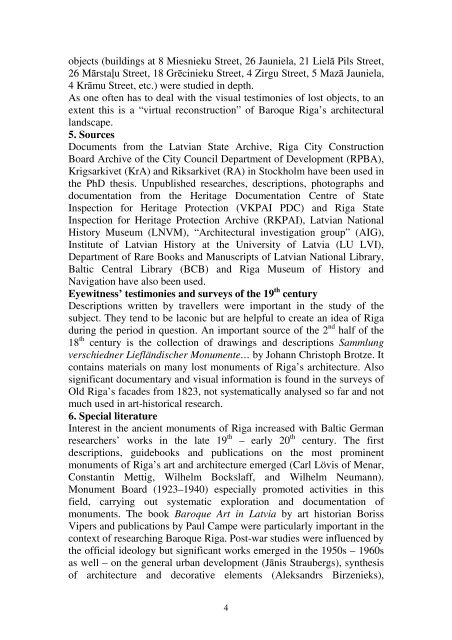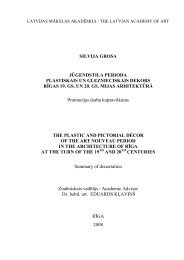Institute of Art History of the Latvian Academy of Art Anna Ancāne ...
Institute of Art History of the Latvian Academy of Art Anna Ancāne ...
Institute of Art History of the Latvian Academy of Art Anna Ancāne ...
Create successful ePaper yourself
Turn your PDF publications into a flip-book with our unique Google optimized e-Paper software.
objects (buildings at 8 Miesnieku Street, 26 Jauniela, 21 Lielā Pils Street,<br />
26 Mārstaļu Street, 18 Grēcinieku Street, 4 Zirgu Street, 5 Mazā Jauniela,<br />
4 Krāmu Street, etc.) were studied in depth.<br />
As one <strong>of</strong>ten has to deal with <strong>the</strong> visual testimonies <strong>of</strong> lost objects, to an<br />
extent this is a “virtual reconstruction” <strong>of</strong> Baroque Riga’s architectural<br />
landscape.<br />
5. Sources<br />
Documents from <strong>the</strong> <strong>Latvian</strong> State Archive, Riga City Construction<br />
Board Archive <strong>of</strong> <strong>the</strong> City Council Department <strong>of</strong> Development (RPBA),<br />
Krigsarkivet (KrA) and Riksarkivet (RA) in Stockholm have been used in<br />
<strong>the</strong> PhD <strong>the</strong>sis. Unpublished researches, descriptions, photographs and<br />
documentation from <strong>the</strong> Heritage Documentation Centre <strong>of</strong> State<br />
Inspection for Heritage Protection (VKPAI PDC) and Riga State<br />
Inspection for Heritage Protection Archive (RKPAI), <strong>Latvian</strong> National<br />
<strong>History</strong> Museum (LNVM), “Architectural investigation group” (AIG),<br />
<strong>Institute</strong> <strong>of</strong> <strong>Latvian</strong> <strong>History</strong> at <strong>the</strong> University <strong>of</strong> Latvia (LU LVI),<br />
Department <strong>of</strong> Rare Books and Manuscripts <strong>of</strong> <strong>Latvian</strong> National Library,<br />
Baltic Central Library (BCB) and Riga Museum <strong>of</strong> <strong>History</strong> and<br />
Navigation have also been used.<br />
Eyewitness’ testimonies and surveys <strong>of</strong> <strong>the</strong> 19 th century<br />
Descriptions written by travellers were important in <strong>the</strong> study <strong>of</strong> <strong>the</strong><br />
subject. They tend to be laconic but are helpful to create an idea <strong>of</strong> Riga<br />
during <strong>the</strong> period in question. An important source <strong>of</strong> <strong>the</strong> 2 nd half <strong>of</strong> <strong>the</strong><br />
18 th century is <strong>the</strong> collection <strong>of</strong> drawings and descriptions Sammlung<br />
verschiedner Liefländischer Monumente… by Johann Christoph Brotze. It<br />
contains materials on many lost monuments <strong>of</strong> Riga’s architecture. Also<br />
significant documentary and visual information is found in <strong>the</strong> surveys <strong>of</strong><br />
Old Riga’s facades from 1823, not systematically analysed so far and not<br />
much used in art-historical research.<br />
6. Special literature<br />
Interest in <strong>the</strong> ancient monuments <strong>of</strong> Riga increased with Baltic German<br />
researchers’ works in <strong>the</strong> late 19 th – early 20 th century. The first<br />
descriptions, guidebooks and publications on <strong>the</strong> most prominent<br />
monuments <strong>of</strong> Riga’s art and architecture emerged (Carl Lövis <strong>of</strong> Menar,<br />
Constantin Mettig, Wilhelm Bockslaff, and Wilhelm Neumann).<br />
Monument Board (1923–1940) especially promoted activities in this<br />
field, carrying out systematic exploration and documentation <strong>of</strong><br />
monuments. The book Baroque <strong>Art</strong> in Latvia by art historian Boriss<br />
Vipers and publications by Paul Campe were particularly important in <strong>the</strong><br />
context <strong>of</strong> researching Baroque Riga. Post-war studies were influenced by<br />
<strong>the</strong> <strong>of</strong>ficial ideology but significant works emerged in <strong>the</strong> 1950s – 1960s<br />
as well – on <strong>the</strong> general urban development (Jānis Straubergs), syn<strong>the</strong>sis<br />
<strong>of</strong> architecture and decorative elements (Aleksandrs Birzenieks),<br />
4












